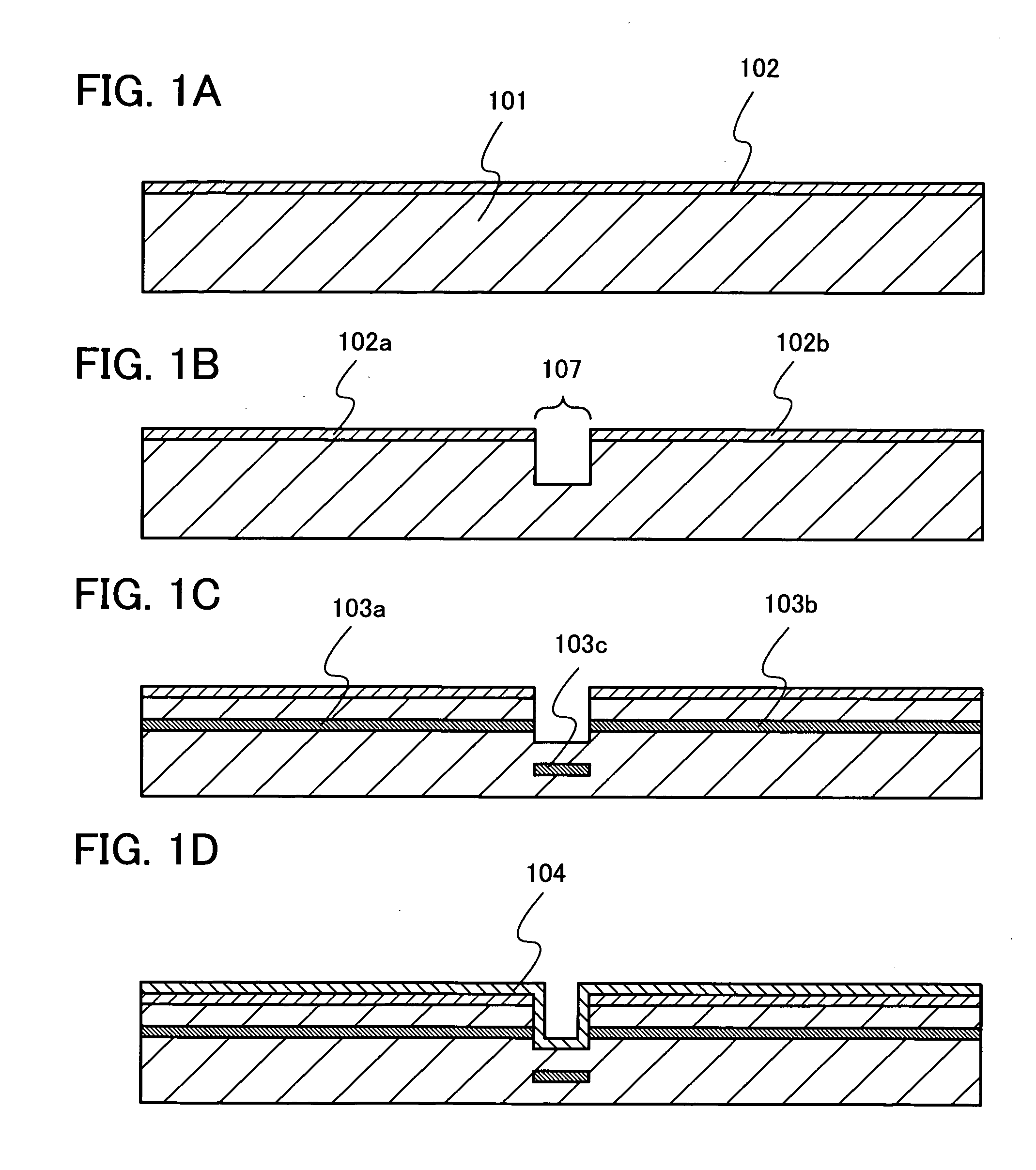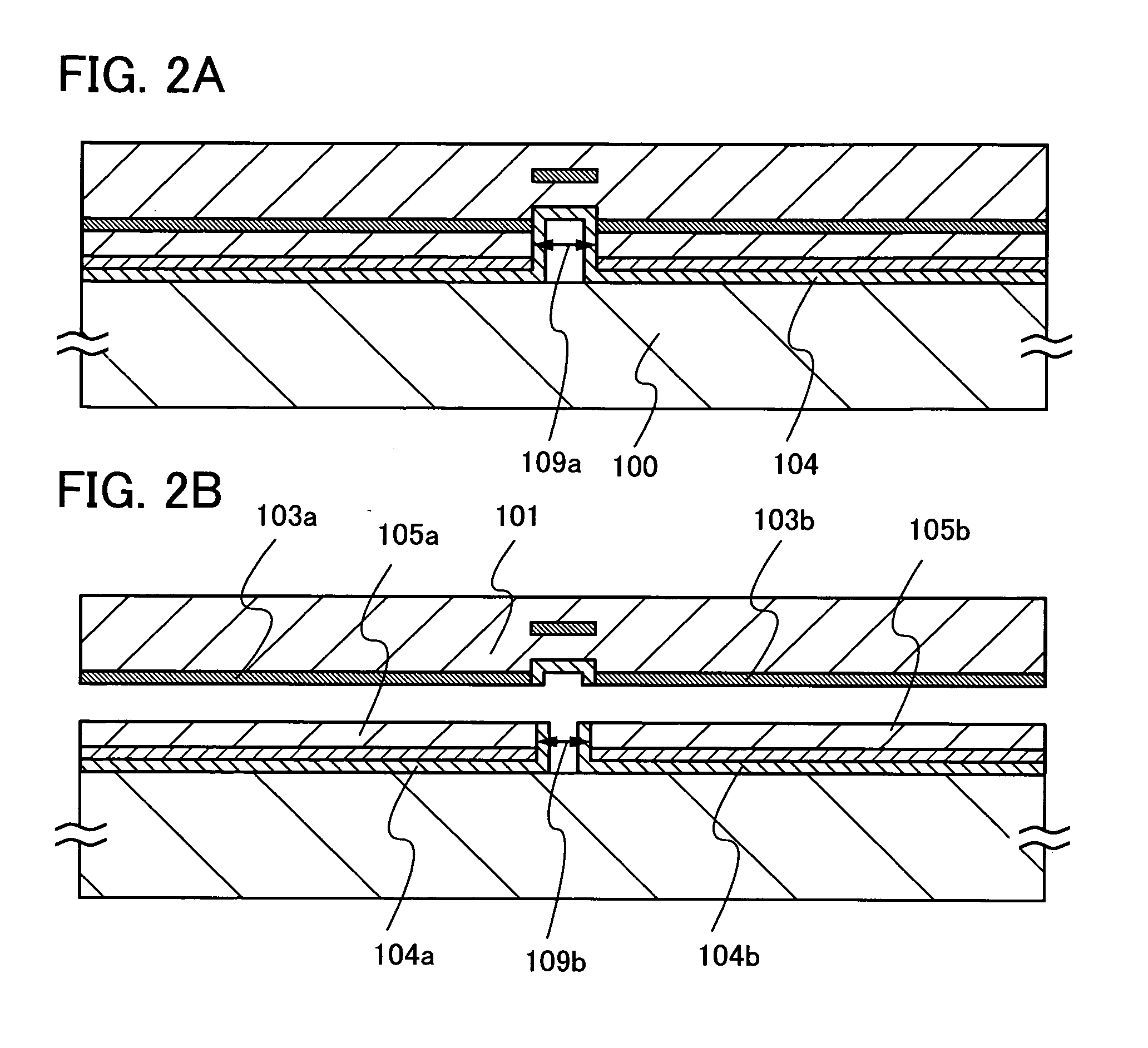Method for manufacturing semiconductor device
a manufacturing method and semiconductor technology, applied in the direction of semiconductor devices, basic electric elements, electrical appliances, etc., can solve the problems of glass substrate shrinkage, yield decline, and decrease of bonding strength between single-crystal silicon layers, and achieve high yield
- Summary
- Abstract
- Description
- Claims
- Application Information
AI Technical Summary
Benefits of technology
Problems solved by technology
Method used
Image
Examples
embodiment mode 1
[0052]In this embodiment mode, a method for manufacturing a semiconductor device with high yield, in consideration of the shrinkage of a supporting substrate in bonding a semiconductor substrate to the supporting substrate and performing heat treatment to separate a part of the semiconductor substrate, is described with reference to FIGS. 1A to 7. FIG. 1A to 4B are cross-sectional views of FIGS. 5 to 7 along A-B. FIG. 5 shows a top view of a semiconductor substrate, and FIGS. 6 and 7 show top views of a supporting substrate.
[0053]In FIG. 1A, as a semiconductor substrate 101, a crystalline semiconductor substrate or a single-crystal semiconductor substrate can be used. Examples of a crystalline semiconductor substrate or a single-crystal semiconductor substrate include a silicon substrate, a germanium substrate, and the like, and alternatively, a substrate of a compound semiconductor such as silicon germanium, gallium arsenide, or indium phosphide can be used. Commercial silicon subs...
embodiment mode 2
[0105]A method for manufacturing a semiconductor device, which is different from that in the above mode, is described with reference to FIGS. 8A to 10C. Here, manufacture of a semiconductor device, by which a semiconductor substrate can be bonded to a supporting substrate with high yield, is described.
[0106]As shown in FIG. 8A, degreasing cleaning is performed on the surface of a semiconductor substrate 101; an oxide film on the surface is removed; and thermal oxidation is performed. As thermal oxidation, general dry oxidation may be performed; however, oxidation in an oxidizing atmosphere to which a halogen is added is preferably performed. For example, heat treatment is performed at a temperature of 700° C. or higher in an atmosphere which contains HCl at 0.5 volume % to 10 volume % (preferably, 3 volume %) with respect to oxygen. The thermal oxidation is preferably performed at a temperature of 950° C. to 1100° C. The processing time may be 0.1 hours to 6 hours, preferably, 0.5 h...
embodiment mode 3
[0129]A method for manufacturing a semiconductor device, which is different from that in the above mode, is described with reference to FIGS. 21A to 21C. Here, manufacture of a semiconductor device, by which a semiconductor substrate can be bonded to a supporting substrate with high yield, is described.
[0130]In a similar manner to Embodiment Mode 2, as shown in FIG. 21A, degreasing cleaning is performed on the surface of a semiconductor substrate 101; an oxide film on the surface is removed; and then, thermal oxidation is performed to form an oxide layer 111 on the surface of the semiconductor substrate 101. Here, by oxidation in an oxidizing atmosphere into which a halogen is introduced, gettering of a metal impurity by a halogen element is performed to compensate defects at the interface between the semiconductor substrate 101 and the oxide layer 111 and to lower local level density at the interface.
[0131]Next, in a similar manner to Embodiment Mode 2, a blocking layer 102 may be ...
PUM
 Login to View More
Login to View More Abstract
Description
Claims
Application Information
 Login to View More
Login to View More - R&D
- Intellectual Property
- Life Sciences
- Materials
- Tech Scout
- Unparalleled Data Quality
- Higher Quality Content
- 60% Fewer Hallucinations
Browse by: Latest US Patents, China's latest patents, Technical Efficacy Thesaurus, Application Domain, Technology Topic, Popular Technical Reports.
© 2025 PatSnap. All rights reserved.Legal|Privacy policy|Modern Slavery Act Transparency Statement|Sitemap|About US| Contact US: help@patsnap.com



